Abstract
The paper describes some practical aspects to justify the need for training and motivating staff to achieve the set results of a small business enterprise. The paper considers a commercial enterprise with the headcount up to 40 people. For such enterprises, commercial success, ensuring the well-being of the company employees, is closely related to the quality of their work. To achieve the required level of the personnel performance, a system of personnel training has been developed. The system is related to the organisation’s goals on the basis of the balanced scorecard (BSC) system methodology. Methods of statistical data processing were used to study the current state of affairs and identify the factors that have the greatest impact on the effectiveness of the organisation. To identify some possible problems in the main process of the organisation, the methodology of risk analysis was used. As a result of the work, staff activity standards have been developed, including the criteria for the staff performance assessment. The head of the organisation has been given an opportunity to manage on the basis of the actual data on the main process effectiveness.
Keywords: Corporate personnelmanagement systemsocially responsible organisationkey performance indicators
Introduction
A socially responsible organisation is a company whose top management execute strategies to improve the living standard of the community and meet the interests of both the organisation itself and all the parties concerned.
One of the most widespread strategies to manage company’s activities is the ISO 9000-based model (Quality management systems. GOST R ISO 9001-20115, 2015). At present, the ISO 9000:2015 model combines several management concepts, for instance, a process approach, risk management, strategic management, knowledge management, resource management at life-cycle stages and others.
While strategic planning, socially responsible organisations implement balanced scorecard (BSC) systems and consider the company’s strategy in the form of goals. In the meantime, ISO 9000:2015 suggests the basic requirements to setting goals in the field of quality and their further adjusting to the common goals of the company. The set goals cover the whole enterprise through the system of clear and user-friendly indicators. This enables creating a balanced, integral and to some extent transparent system of measurements which ensures both decision making and performance assessment of the measures taken. Consequently, one of the fundamental premises of quality management – fact-based management is realised.
The paper describes a small business enterprise in furniture retail.
Trade enterprises serve as a link between manufacturers and consumers. The link preconditions the requirements of work with suppliers, equipment and office design, technologies of assortment range planning, purchase and after-sales processes organisation. Management originality in trade and retail is defined by its aiming at placing the product proposal in the right place at the right time.
About a half of all small businesses in the Russian Federation operate in the field of trade. The Russian trade management in its turn can be defined as an infant branch of professional subject area.
The principle factor to achieve a commercial success in such a company is the quality of personnel performance. The personnel are to be competent and qualified; their qualification is to be improved through various advanced training and development programmes. The trained staff attract more clients so that the company gets more profit and can reward the staff for their contribution, supporting their adequate standard of living.
Problem Statement
To increase efficiency and effectiveness of company’s operations it is essential to identify the possibilities for further improvement.
Activity of some trade points in cabinet-type furniture retail was analysed. The sales volume of four trade points was compared with the help of the software package MS Office Excel (Data analysis – On-way analysis of variance (ANOVA).
The period for the data analysed was May, 2015 – April, 2016. Fig.
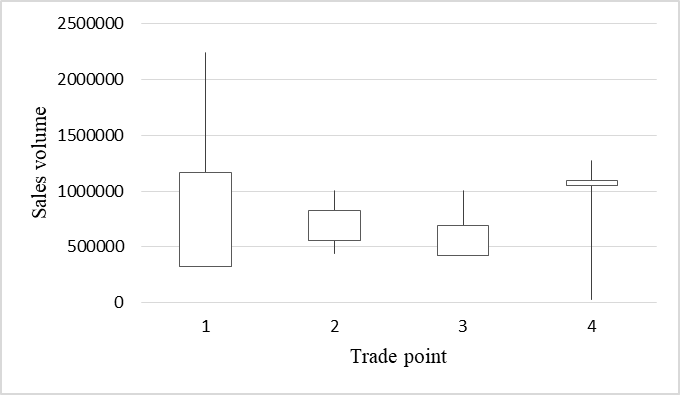
The one-way ANOVA test was run to check the similarities in the sales volume of the given trade points. The test demonstrated the inequality of the average sales volumes of the trade points under study. The results of the Tukey-Cramer Procedure concluded the significant difference between the sales volumes of Trade point 1 and Trade point 4.
The regression analysis of the data was conducted to figure out the factors, affecting the sales volume in each trade point. One year data were used and the following variables were identified:
Sales volume – dependent variable (Y1).
Salaries and emoluments (X1), advertising expenditure (X2), number of reclamations (X3) - explanatory variables.
The conducted analysis resulted in the following conclusion: in all the four cases salaries and emoluments have the highest impact on the sales volume in comparison with those of advertising expenditures and the number of reclamations; thus, an individual and their material wealth influence the process results. Financial encouragement shapes the sense of justice of the employee, their sense of “material compensation” for the labour put in. All the measures of payment and stimulation create the welfare of employees, their sense of security. Meanwhile the sales volume and the salary have strong correlation dependence; the correlation coefficient is 0.8.
The direct labour process in the company’s operations – the cabinet-type furniture sales – falls into several steps.
Step 1. Acquaintance and establishment of the contact with a client. On the step, the sales assistant is to introduce themselves and produce their business card.
Step 2. Needs analysis. The sales assistant should ask a series of clarifying questions to specify the client’s needs.
Step 3. Design project. The sales assistant creates the design project of the furniture arrangement and sustains the conservation, asking the client additional questions to refine the query, explains their actions and offers to estimate the work progress. The sales assistant then presents the overall project and clarifies if the client is satisfied with the design project. The client may either accept or decline the project. On the contact completion, the sales assistant is to provide the client with some promotional materials.
The process efficiency greatly depends on the individual sales assistants and their standard of professionalism. The possible errors of the sales assistant, their causes and results as well as the preventive actions were identified by means of the method “Human errors impact analysis” (Table
Fig.
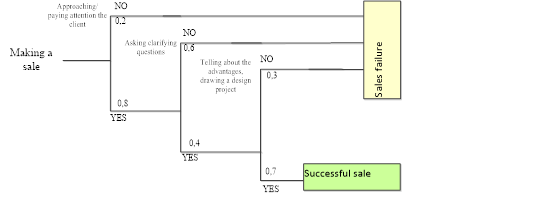
In the course of the product sales analysis, three steps were identified that may result in the negative outcome. The following calculations were made: probability of sales success = 0.224; probability of the sales failure on various steps P1=0.2; P2=0.48; P3=0.096. The probability of a successful sale is greater than the probability of an error at the stage of acquaintance and that of presentation, but below the probability of an error at the stage of clarification and development of the contact. The loss of the client at the second stage is quite a frequent problem. This is due to the fact that some sales assistants do not know how to start a dialogue with the client properly, so that they do not want to leave. To prevent the loss of the client, it is necessary to constantly train and monitor sales assistants, show personal sales examples, share good examples of questions.
Research Questions
Training sales assistants will improve the effectiveness of the company as well as the financial performance and employee compensation.
Training is also a component of sales assistants’ motivation, as it increases their competence and competitiveness in the labour market.
Purpose of the Study
The work aims to develop a system of personnel training, based on performance assessment indicators, linking the mission and business strategy with the specific objectives and operational plans of the enterprise.
Research Methods
To design the training program, a strategic enterprise map, based on the BSC system and a process approach to the activity organisation, was developed (Kaplan, 2013).
Findings
The process of company’s personnel management was presented in the form of a PDCA cycle (Figure
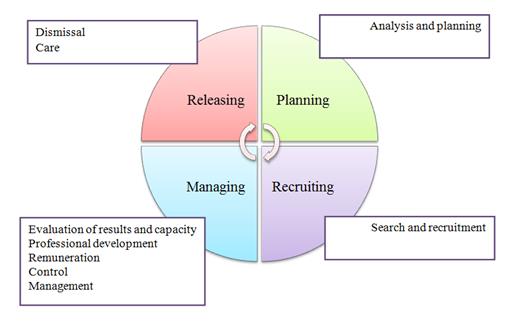
Planning
Planning is the initial stage of the management process. The disadvantages of planning further affect the implementation effectiveness of other management functions. For the company’s activity planning, a BSC system was used, which includes four components: training and development; clients; business processes; finance (Panov, 2014).
The personnel management system based on the BSC is a mechanism for the consistent delivery of strategic goals to the company and key success factors through strategy maps, and further monitoring of their achievement through the so-called key performance indicators (Rampersad, 2009).
After conducting interviews with the manager and employees, a scheme of goals and indicators of the enterprise was developed. See Figure
The scheme presented contains: goals, directed cause-effect relationships, prospects and indicators. The perspective on the map is designated as a horizontal track with the goal inside. The indicators are attached to the goals on the strategy map (Kaplan, 2012). Each goal can be described by an arbitrary number of indicators. For example, the goal of “Creating a favourable climate in a team” can be described by the indicator “Staff engagement in corporate events”.
The establishment of cause-effect relationships between the goals and indicators of various promising directions allowed abandoning the norms and initiatives that did not influence the achievement of the company’s strategic goals. For instance, it was decided to eliminate such an indicator as “Secondary supplier sales plan completion” due to the fact that the sales assistant spends a lot of time on smaller sales.
Schemes of goals and indicators allow conveying the role in the implementation of the strategy to individual departments and employees of the company. Since all the information is listed on one page, a relatively simple strategic communication becomes possible.
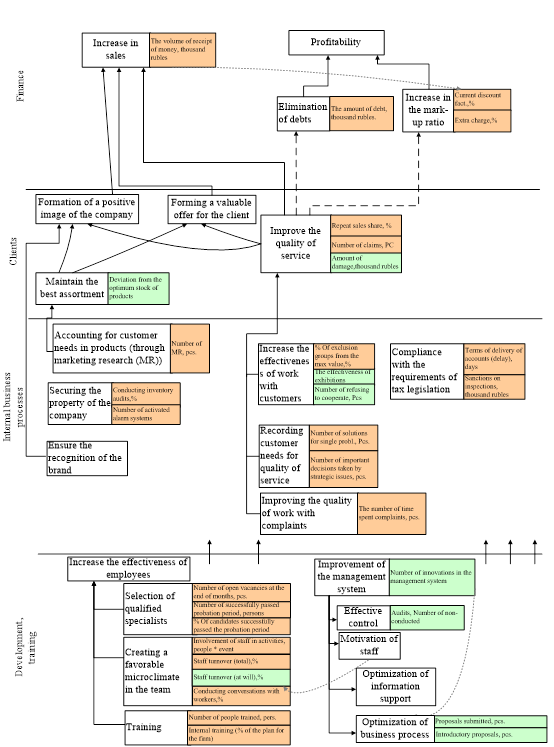
The BSC system makes it possible to assess the performance of employees . At the enterprise under consideration, a self-functioning mechanism operates, the principles of which are as follows:
they did themselves – they distinguished themselves, i.e. the responsibility for carrying out the reporting event is borne by the employee. This motivates them not to wait until they are “called” to the report, but initiate the event by themselves;
not to check, but take a report on the results of the activity, i.e. the chief executive focuses on listening to the employee’s report, clarifying, correcting and asking questions;
forcing the situation, i.е. the responsibility of the employee should be increased with each repeated failure to fulfil the same task.
Greater attention should be paid to the selection and training of employees. It is also important to form the internal environment of the organisation, by introducing the unified company’s standards of work, devoting time to the corporate culture development.
Search and recruitment
At the stage of staff selection, it is important to determine whether the applicant meets the requirements of the enterprise. For this purpose, decision-making schemes were developed. Managers would always prefer to recruit some trained, competent and experienced employees, as the company can incur financial losses associated with sales failure, while a new employee will gain experience. However, even qualified personnel need regular training, as the methods and techniques of working with people are constantly developing; the assortment range and sales strategy of the organisation are changing (Henderson, 2012).
Training
Figure
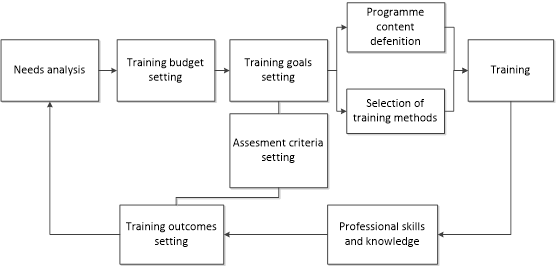
The training system is built on the basis of the requirements for different categories of employees, and includes two programs (Plotnikov, 2013, Plotnikova, 2017):
an expanded training program designed for trainees to ensure their progress to the level of a sales assistant;
a supportive training program. This program is aimed at maintaining skills, acquiring new knowledge and skills.
As a result of this approach, all personnel are involved in the learning and development process (Plotnikova, Redko & Yanushevskaya 2016). Training in the company takes place on the regular basis: daily, weekly, monthly, quarterly or twice a year.
To standardise the learning process, the company prepared a set of documents:
a sales standard or corporate sales book, which contains the information about the company and the characteristics of the materials;
a reference book on materials, components, accessories with their main characteristics;
product catalogues;
video materials;
cards of goods.
To improve the quality of interaction with clients, the company management decided to develop and apply the “Performance standards for sales assistants”.
The first stage in the development was the study of additional literature sources and participation in online webinars dedicated to training staff in the company.
The second stage was the allocation of sections and the main stages of communication with the client, interviews with sales assistants, and analysis of the competitors’ work. At this stage, a training toolkit was compiled, which included the following sections:
Introduction
Standard stages for work with the client
Furniture purchasing specificity
Contact establishing
Examples of recommended phrases
Elevator pitch projects of the company
Needs Analysis
Sample questions to the client
The technique of “presentation-question-response”
Presentation
Design project for furniture arrangement
Additional sales
Working with objections
Completion of sales
Online questionnaires were conducted for sales assistants. The questionnaires contained questions for each stage of the communication process with customers and were arranged into the Google Forms. The results were summarized in the overall rating table. The head of the company also participated in the survey.
An introductory course was created for sales assistant nominees. The four-day course included the compulsory training blocks for beginners: the required documentation; product range and main suppliers; modelling in the 3D program; working with clients: consulting.
Evaluation of results
To assess the skills of employees or to get the information about possible problems of employees in the new workplace, a skill matrix was developed (Figure
The overall goal of all types of accounting is streamlining the information flows for their efficient use in making managerial decisions and preserving information for the archive.
Accounting creates the possibility of the real implementation of monitoring the progress of the activity and its results at the enterprise (Fisenko & Kuleshova, 2012).
The company created reports, such as: daily, monthly reports and those with an accrual result.
For quick and transparent reflection and result analysis, the documents were created for the retail sales department, as well as a provision on reporting, which prescribes deadlines, responsible executives, forms of delivery and so on.
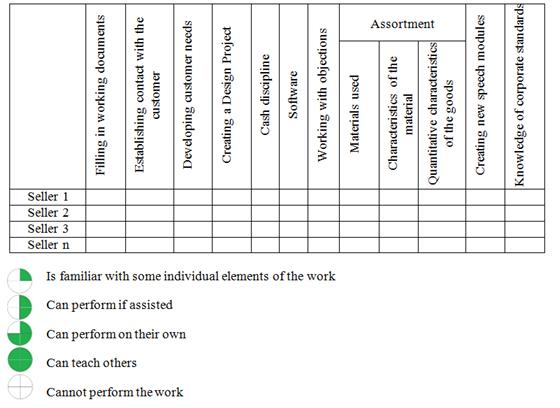
Conclusion
The paper considers the system of personnel training as a component of the quality management system of an enterprise, occupied with sales of cabinet type furniture.
Statistical methods have enabled us to conclude that the personnel in the given organisation significantly affects the result of the main process – “product realisation”. Based on human factor impact analysis, the most important stages of the process have been determined to ensure its effectiveness.
Considering the staff as the key factor to achieve the enterprise objectives, the process of staff training based on the objectives and performance indicators of the enterprise has been designed. It can serve as a tool for planning activities, controlling, delegating and staff motivating (Moskaleva, 2016). Training programs for trainees and sales assistants have been developed. Sales assistant work with the client has been standardised.
As a result, the effectiveness of the organisation management system has increased. The manager has received a possibility to manage the organisation on the basis of facts, analyse the activities of employees and the organisation as a whole.
References
- Fisenko, A.I., Kuleshova, E. A. (2012). Balanced system of indicators: a new paradigm or a new format of use? Actual problems of economics, sociology and law, 3, 122-130.
- Henderson, R. (2012). Compensation management. St. Petersburg. (in Russian)
- ISO 9001. Quality management systems. (2017, May 25). Retrieved from http:// http://docs.cntd.ru/document/1200124394
- Kaplan, R S. (2012). Strategic maps. Transformation of intangible assets into tangible results. Moscow: ZAO Olimp-Business. (in Russian)
- Kaplan, R. S. (2013). Balanced Scorecard. From strategy to action. Moscow: ZAO Olimp-Business. (in Russian)
- Moskaleva, E.G. (2016). Implementation of the personnel motivation system based on KPI - key indicators of effectiveness. The content, 2 (43), 109-119. (in Russian)
- Panov, M.M. (2014). Evaluation of activities and management system of the company based on KPI. Moscow: Infra-M. (in Russian)
- Plotnikov A.V. (2013). Peculiarities of creating the BSC as a strategic business management system. Management in Russia and abroad, 3, 106-112. (in Russian)
- Plotnikova, I. V. (2017). Developing a Medical Institution Management System through Promoting Social Accountability. EpSBS: Lifelong Wellbeing in the World (WELLSO 2016), 19, 603-612. (2017, May 25). Retrieved from http://dx.doi.org/10.15405/epsbs.2017.01.81
- Plotnikova, I. V., Redko L.A. & Yanushevskaya M. N. (2016). Social Responsibility of Business. EpSBS: Lifelong Wellbeing in the World (WELLSO 2015), 7, 173-180. (2017, May 25). Retrieved from http:// dx.doi.org/10.15405/epsbs.2016.02.24
- Rampersad, H. (2009). The universal system of indicators: How to achieve results, preserving integrity. Moscow: Alpina Pablisher. (in Russian)
Copyright information

This work is licensed under a Creative Commons Attribution-NonCommercial-NoDerivatives 4.0 International License.
About this article
Publication Date
16 April 2018
Article Doi
eBook ISBN
978-1-80296-037-2
Publisher
Future Academy
Volume
38
Print ISBN (optional)
-
Edition Number
1st Edition
Pages
1-509
Subjects
Social welfare, social services, personal health, public health
Cite this article as:
Nefedova, K., Redko, L., & Yanushevslaya, M. (2018). Personnel Training System As A Management Component Of A Socially Responsible Organisation. In F. Casati, G. А. Barysheva, & W. Krieger (Eds.), Lifelong Wellbeing in the World - WELLSO 2017, vol 38. European Proceedings of Social and Behavioural Sciences (pp. 484-494). Future Academy. https://doi.org/10.15405/epsbs.2018.04.56

